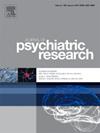强迫症的自闭特征:系统回顾与荟萃分析
IF 3.7
2区 医学
Q1 PSYCHIATRY
引用次数: 0
摘要
背景:一些证据表明强迫症与自闭症谱系障碍和更广泛的自闭症表型之间有很强的联系。然而,重叠自闭症特征的程度和性质尚未完全了解。方法采用Pubmed和Scopus数据库对1990年12月至2025年3月强迫症患者与健康对照组的自闭症特征进行系统评价。进行随机效应荟萃分析。结果目前的荟萃分析包括27项研究,包括1677名强迫症患者和1239名健康对照。与健康对照组相比,强迫症患者的总自闭症特征(g = 1.27, CI = 1.02, 1.53)、社交领域评分(g = 0.98, CI = 0.66, 1.31)和限制/重复行为(RRBs)领域评分(g = 1.65, CI = 1.27, 2.04)均有所增加。强迫症症状与RRBs域得分的相关性(r = 0.34, CI = 0.19, 0.48)高于社交交际域得分(r = 0.18, CI = 0.09, 0.27)。结论socd与RRBs和社交领域的显著升高有关。强迫症的一个重要子集出现在具有自闭症特征的青少年中,尤其是RRBs。在成年人中,社交得分的提高可能,至少部分地反映了慢性强迫症症状对社交功能的影响,而不是这一领域的真正提高。本文章由计算机程序翻译,如有差异,请以英文原文为准。
Autistic traits in obsessive compulsive disorder: A systematic review and meta-analysis
Background
Several lines of evidence point to a strong association between OCD and autism-spectrum disorder and broader autism phenotype. However, the extent and nature of overlapping autistic traits has not been completely understood.
Method
A systematic review in Pubmed and Scopus databases was performed to compare autistic traits between OCD patients and healthy controls (December 1990 to March 2025). A random-effects meta-analyses were conducted.
Results
Current meta-analysis included 27 studies consisting of 1677 patients with OCD and 1239 healthy controls. Compared to healthy controls, total autistic traits (g = 1.27, CI = 1.02, 1.53), also ratings in social-communication domain (g = 0.98, CI = 0.66, 1.31), and restricted/repetitive behaviors (RRBs) domain (g = 1.65, CI = 1.27, 2.04) were increased in OCD patients. OCD symptoms were more strongly related to RRBs domain scores (r = 0.34, CI = 0.19, 0.48) than social-communication domain scores (r = 0.18, CI = 0.09, 0.27).
Conclusions
OCD is associated with significant increases in both RRBs and social-communication domains. A substantial subset of OCD emerges in youth who have autistic traits, particularly RRBs. In adults, elevated social-communication scores might, at least partly, reflect the effect of chronic OCD symptoms on social functioning rather than true increase in this domain.
求助全文
通过发布文献求助,成功后即可免费获取论文全文。
去求助
来源期刊

Journal of psychiatric research
医学-精神病学
CiteScore
7.30
自引率
2.10%
发文量
622
审稿时长
130 days
期刊介绍:
Founded in 1961 to report on the latest work in psychiatry and cognate disciplines, the Journal of Psychiatric Research is dedicated to innovative and timely studies of four important areas of research:
(1) clinical studies of all disciplines relating to psychiatric illness, as well as normal human behaviour, including biochemical, physiological, genetic, environmental, social, psychological and epidemiological factors;
(2) basic studies pertaining to psychiatry in such fields as neuropsychopharmacology, neuroendocrinology, electrophysiology, genetics, experimental psychology and epidemiology;
(3) the growing application of clinical laboratory techniques in psychiatry, including imagery and spectroscopy of the brain, molecular biology and computer sciences;
 求助内容:
求助内容: 应助结果提醒方式:
应助结果提醒方式:


